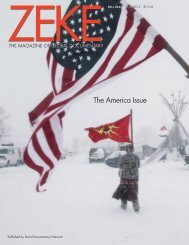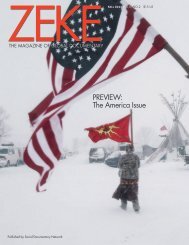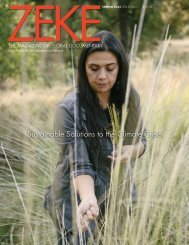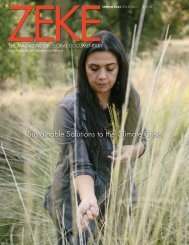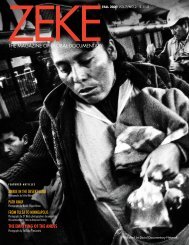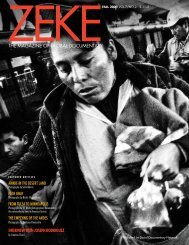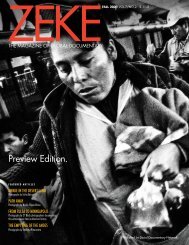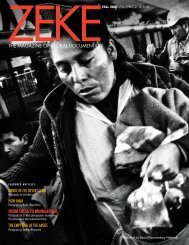ZEKE Fall 2019
Contents includes: "Youth of Belfast" by Toby Binder, and "Delta Hill Riders" by Rory Doyle, winners of ZEKE Award for Documentary Photography "Rising Tides" with photographs by Sean Gallagher, Lauren Owens Lambert, and Michael O. Snyder "Out of the Shadows: Shamed Teen Mothers of Rwanda" by Carol Allen Storey Interview with Lekgetho Makola, Head of Market Photo Workshop, South Africa, by Caterina Clerici "Why Good Pictures of Bad Things Matter" by Glenn Ruga Book Reviews and more...
Contents includes:
"Youth of Belfast" by Toby Binder, and "Delta Hill Riders" by Rory Doyle, winners of ZEKE Award for Documentary Photography
"Rising Tides" with photographs by Sean Gallagher, Lauren Owens Lambert, and Michael O. Snyder
"Out of the Shadows: Shamed Teen Mothers of Rwanda" by Carol Allen Storey
Interview with Lekgetho Makola, Head of Market Photo Workshop, South Africa, by Caterina Clerici
"Why Good Pictures of Bad Things Matter" by Glenn Ruga
Book Reviews and more...
- No tags were found...
You also want an ePaper? Increase the reach of your titles
YUMPU automatically turns print PDFs into web optimized ePapers that Google loves.
of how to use their bodies. A bedrock foundation<br />
of patriarchy is the historic societal<br />
expectation (read obligation) for all<br />
women to bear children. Author Rebecca<br />
Solnit challenges this restrictive definition<br />
of womanhood in her book, The Mother<br />
of All Questions, when she spotlights this<br />
implicit mandate put upon the female<br />
gender; “Woman, who must marry, must<br />
breed, must let men in and babies out, like<br />
some elevator for the species…Brains are<br />
individual phenomena producing wildly<br />
varying products: uteruses bring forth one<br />
kind of creation.”<br />
Donna Ferrato has changed the universal<br />
landscape for all victims of domestic<br />
violence, the millions of women, men and<br />
children affected on a daily basis. The state<br />
of Massachusetts claimed intimate-partner<br />
violence as a public health emergency<br />
in 2008, noting it’s correlation to, and<br />
creation of, a complex matrix of related<br />
social, psychological and medical crises.<br />
Mental health, incarceration, family and<br />
children services buckle under the staggering<br />
numbers of people affected by domestic<br />
violence. Ferrato established the Domestic<br />
Abuse Project in 1979 with a mission to<br />
eradicate domestic violence and create<br />
communities where families experience<br />
healthy, safe and equal relationships. In<br />
2014 she launched a campaign for women<br />
who left abusers called, I Am Unbeatable.<br />
Two bodies of work from Holy are<br />
currently being exhibited as part of Photo<br />
Espana. At seventy years of age, Ferrato is<br />
as driven to create positive societal change<br />
today as when she began forty years ago.<br />
She has heard and amplified the collective<br />
voices of women internationally. She<br />
photographs the contemporary reality of<br />
women demanding equal representation<br />
in, and protection by, governmental law<br />
in multiple countries. Author Ursula K. Le<br />
Guin succinctly states the power of such<br />
fundamental change. “We are volcanoes.<br />
When we women offer our experience as<br />
our truth, all the maps change. There are<br />
new mountains.” Ferrato’s dedication to<br />
create a true visual narrative contributed<br />
to our current explosion which is altering<br />
our communal landscape. Ferrato knew<br />
what was real all along—woman, on her<br />
own is sacred and wholly. Individually and<br />
collectively we are unbeatable.<br />
—J. Sybylla Smith<br />
A FIELD GUIDE TO<br />
ASBESTOS<br />
By Louie Palu<br />
Essay by Alison Nordström<br />
Yoffy<br />
72 pages | $25.00<br />
Often the<br />
goal of<br />
writing<br />
a book review is<br />
to comment on<br />
the contents of a<br />
book. The book<br />
as an object is<br />
invisible — a<br />
container for the<br />
contents, such as a shoebox holding a<br />
pair of ruby slippers. Louie Palu turns<br />
this on its head with A Field Guide to<br />
Asbestos. This is certainly not a book<br />
of Palu’s photographs, although his<br />
photos are used in the book. A Field<br />
Guide to Asbestos is performance art. It<br />
nominally takes the form of a field guide<br />
where we might expect to see images of<br />
plants and insects, but instead he pours<br />
in content of all types relating to the<br />
destructive consequences to the soft tissues<br />
of the human body when exposed<br />
to the silicate asbestos, most often used<br />
in building materials as a shield for fire,<br />
and most tragically resulting in slow<br />
death as a result of long-term exposure.<br />
Palu is no longer in his comfort zone<br />
here. In the past, he has made a career of<br />
making extraordinary images of mine workers<br />
and soldiers to tell complex stories about<br />
the heroic and dangerous work that people<br />
must do to survive. Now he has entered the<br />
world of conceptual art, creating an object,<br />
a book, to tell a story of asbestos, no less<br />
dangerous and no less destructive than war<br />
or deep underground mining.<br />
For most of the history of photography,<br />
a photo book began with the rectangular<br />
photograph that would impart meaning by<br />
a combination of its representational and<br />
formal qualities. The representational qualities<br />
might be the face of a US Marine in<br />
Afghanistan or a miner in Quebec—both<br />
subjects of Louie Palu’s earlier work. The<br />
formal qualities might be contrast, use of<br />
color (or not), scale, perspective, focus—all<br />
of which Palu has shown mastery of with<br />
his previous work.<br />
Enter the photo book of today. Now, the<br />
rather limited variables available to a photographer<br />
are exponentially expanded by<br />
the choices available to a book designer-<br />
-sequence, typography, paper stock, binding,<br />
concept, etc. While in the past, these<br />
elements were subservient to the content,<br />
today they are the content.<br />
The first impression of A Field Guide<br />
to Asbestos is the size and materials. It<br />
is small—it can almost fit in the palm of<br />
one’s hand. The cover is stiff paper without<br />
a photo, as if it was an industrial field<br />
manual. The book begins with a snapshot,<br />
clearly not by Palu, taken in 1952 of youthful<br />
Harold and Blayne Kinart at their home<br />
in Ontario, Canada. Turning the page,<br />
the next photo is of a skeletal Blayne, 52<br />
years later having pain medication patches<br />
applied on his back by his wife Sandy.<br />
(Blayne died in 2004 of mesothelioma<br />
from exposure to asbestos — the process of<br />
which Palu powerfully documents.)<br />
On page 3 begins the most traditional<br />
element of a photo book — the essay. In<br />
this case it is a smart and informative one<br />
by Alison Nordström who does a brilliant<br />
job dissecting the tragedy of asbestos in<br />
recent human history and critiquing the<br />
book as an object.<br />
The book progresses with photos by Palu<br />
of people who have been exposed to, and<br />
in many cases devastated by asbestos in<br />
Canada, the US, and in India; remarkable<br />
images of asbestos mining waste; interviews<br />
with experts on asbestos; historical<br />
photos of asbestos in use; an essay by the<br />
photographer; and closes with a series of<br />
color snapshots (not by Palu) of people who<br />
eventually died from exposure to asbestos.<br />
The closing sentence of Palu’s essay, the<br />
<strong>ZEKE</strong> FALL <strong>2019</strong>/ 57









